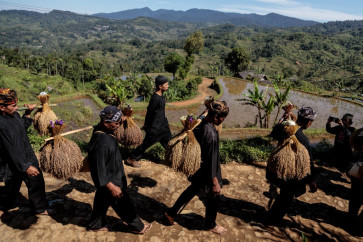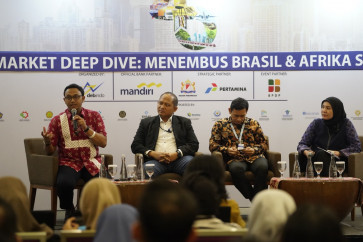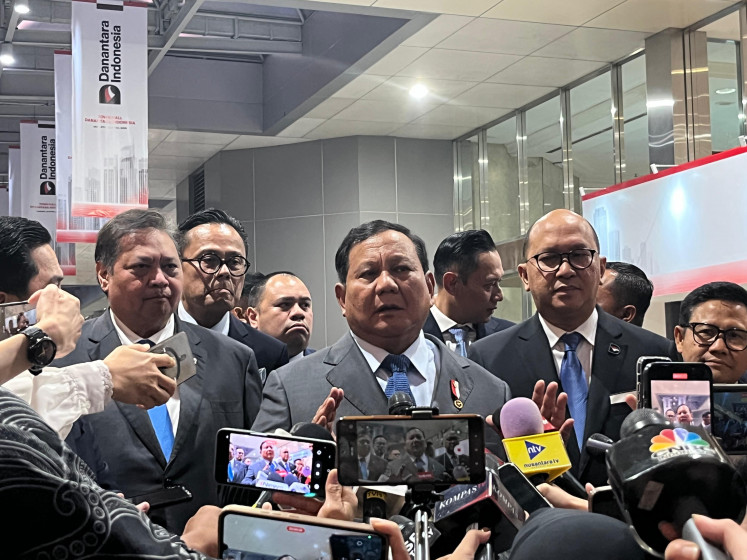Popular Reads
Top Results
Can't find what you're looking for?
View all search resultsPopular Reads
Top Results
Can't find what you're looking for?
View all search resultsRural industry pressing to minimize urbanization
Every year, urbanization becomes a headache after Lebaran, or Idul Fitri, primarily for a big city such as Jakarta
Change text size
Gift Premium Articles
to Anyone
E
very year, urbanization becomes a headache after Lebaran, or Idul Fitri, primarily for a big city such as Jakarta. About 60,000 newcomers arrive in Jakarta every year, with the local government not knowing how to
effectively prevent inmigration.
The ability of the Jakarta government to address this problem is also limited. It can only call on the people not to bring relatives back to Jakarta. Further, it conducts regular ID-card checks on newcomers, but it seems ineffective in controlling population growth.
To protect Jakarta from the burden of the uncontrollable population boom, distribution of economic growth and development must be an ideal solution. We know that rural people stream into Jakarta due to a perception that the capital city is the source of wealth, where they can find jobs and generate income easily. Many policies aimed at preventing people moving from rural areas to Jakarta are rendered meaningless without creating a rural area as a source of welfare for its people, which is the central government’s responsibility.
To date, poor people are concentrated in rural areas. Data from Indonesian Statistics (2011) said that 64 percent of the Indonesian population lived in rural areas, with 31.2 million of them classified as living
in poverty.
The fact indicates that rural development should be the main priority of the country’s poverty alleviation agenda if the government does not want to see urbanization, hence urban impoverishment, intensify.
So far, rural development has been restricted to agricultural development, especially on the off farm side. As we may be aware, the ability of an off-farm business to provide decent income for farmers has been declining from day to day. Too small land ownership, stagnation in technological development and expensive input costs such as seeds and fertilizer have made it more difficult for farmers to increase their income. That is why urbanization is seen as an attractive choice for the people. In this case, the government needs to renew their rural development strategy since the old strategy is not effective anymore.
Basically, there are three components that can be considered the indicator of rural development. The first is the natural environment. Natural resources and wildlife are necessary requirements to reach a good quality of life and give opportunities to enhance the economic level of the rural population.
Many urban people visit rural areas because of its nature that is free from air pollution, beautiful landscape and so forth. These factors can be exploited as a business opportunity such as tourism.
Second is social well-being. Quality of social life can be an important component of rural development. Good quality means good education and health; and reduced risks and vulnerability of the people.
The last component is economic well-being. Easy access to jobs and income is an important indicator of rural development.
To fulfill the three requirements, the government should not solely rely on agricultural development. An integrated strategy by connecting the agricultural to the industrial sector is a reasonable policy that can be taken into account to renew rural development strategy in Indonesia. In this case, the development of the food processing industry will turn rural areas into a center of economic activities that will stimulate social and economic well-being and finally minimize urbanization.
As we know that the food processing industry generates added value by transforming agricultural raw materials into products that are marketable and usable, have improved storability and nutritive value, and enhance income and profitability of producers.
The presence of the food processing industry in rural areas will raise farmers’ income, unlike in today’s practice in which traders and brokers profit the most from agricultural products due to their direct access to market. The
food processing in rural area will reduce intermediaries, therefore farmers will receive a higher price for their products.
Today, the preference of young people to work in the industrial sectors is higher than in the agricultural sector. The rural industry will change the trend and offer ample jobs for the workforce. At the end of the day, employment in rural area will curb urbanization.
Since the food processing industry needs more advanced knowledge and technology than traditional agriculture, more skilled laborers is mandatory. This may encourage people in rural areas to improve their education to meet the standard of industrial workers. The implication is education institution will follow the growth of the food processing industry.
However, a common feature of recent writings (i.e. Asheim, 1996; North and Smallbone, 1998) put small and medium enterprises (SMEs) as the key factors influencing the success of local economies. One of the reasons for focusing on SMEs is that they are seen as having a higher propensity to innovate than larger firms because they are thought to be more flexible, dynamic and responsive to shifts in demand and changes in
economic conditions.
The development of SMEs in food processing can be a solution to develop rural area in Indonesia. Beside, the initial cost to develop SMEs is lower than large companies and the ability of SMEs to absorb workers is higher than big enterprises. SMEs in food processing business suit the rural area, where raw materials are abundant. In addition, SMEs are potential to develop entrepreneurship in the rural area.
Giving the food processing SMEs the lead role in rural development can stimulate other sectors to grow. Finally, a good quality of life in rural areas will discourage an exodus to urban areas, especially Jakarta.
The writer, a PhD candidate at the University of Tokyo, is lecturer at the Department of Management, the Bogor Institute of Agriculture.










